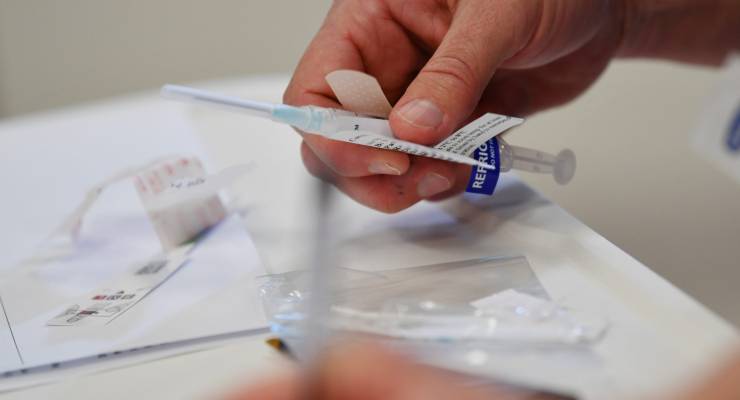
As millions of people around the world receive coronavirus vaccines, the Morrison government remains adamant Australians must wait until March.
Despite former politicians, epidemiologists, business leaders and Labor joining the chorus calling for a quicker rollout, Prime Minister Scott Morrison maintains going too fast would be “very dangerous”.
But the frustration is understandable. Although Australia isn’t struggling with over-burdened hospitals and thousands of deaths, constant border closures and grumbling case numbers have caused a summer of angst. A quicker rollout could bring much needed relief from uncertainty.
So does the government’s argument for a slow and steady approach stand up?
What’s the timeline?
Health Minister Greg Hunt confirmed to The Daily Telegraph this morning that Australians would start being inoculated in early March, and the Pfizer vaccine would be the first to be used.
Before that happens the vaccines need to be approved by the Therapeutic Goods Administration. The TGA is expected to approve the Pfizer vaccine in late January and has asked for more data on the Oxford-AstraZeneca vaccine by the end of the month.
But the first batches of the AstraZeneca vaccine are likely to arrive in Australia from late January. Australia also has a vaccine deal with Novavax, but that isn’t expected to arrive until later in the year.
Why the wait?
The government says Australia is taking its time and letting the TGA review things thoroughly because we can afford to wait. Unlike Britain and the United States, where vaccines have been granted emergency authorisation, Australia’s low case numbers and relatively controlled clusters make it different.
“Even with the current situation in NSW and Victoria, we can afford to wait for the TGA to do its job and make sure we’re getting a safe, effective and quality vaccine,” Monash University epidemiologist Professor Allen Cheng wrote on Twitter.
But if the TGA approves a vaccine in late January or early February, and doses are available, why wait until March?
Yesterday Morrison said that once approved, individual batches of vaccine would need to be tested. But that should take only about a fortnight.
Labor has gone on the attack, saying talk of getting approvals right is the Coalition’s attempt to spin its failure to get a deal with manufacturers in time.
“It makes no sense for the TGA to have recommended — as it is likely to do in January — the approval of the Pfizer vaccine, but then for the rollout to not occur until March,” Labor leader Anthony Albanese said.
“What we know is that Australia is not at the front of the queue. We have never been at the front of the queue.”
Logistical challenges
But even with the planned timeline there’s a lot we don’t know about our vaccination program, which indicates the March date could reflect the government’s recognition of the major logistical challenges.
“There’s a lot of detail that the public and health professionals haven’t been given yet, which suggests to me that it’s still getting organised,” University of Sydney vaccination expert Julie Leask said.
A key challenge will be the federal government working in an area — immunisation — traditionally administered by state health departments.
“It’s where those two jurisdictions and entities meet that you can get gaps or problematic overlaps,” Leask said.
“I can guarantee you that some of the issues that arise will be about confusion with state and federal responsibilities.”
A slightly slower timeline could give health services and general practitioners more time to ensure that when vaccines are delivered they’re done so properly.
What about the rest of the world?
By international standards, Australia’s vaccine timeline might seem frustratingly slow. But countries which rushed the rollout are seeing why that’s so difficult.
The Trump administration wanted 20 million people to get their first dose by the end of 2020, but that number was closer to 3 million, with delays, backlogs and poor communication between state and federal health bodies leaving vials of vaccine unused.
In the UK, rollout has been hampered by red tape and shortages. There’s anger and confusion at a decision to delay the second dose for 12 weeks.
Then there’s Israel. The poster child for vaccine delivery has won plaudits for inoculating 13% of its population. But it is refusing to vaccinate Palestinians in occupied territories while giving the jab to Jewish settlers, a move sharply criticised by human rights groups.
The point is, no country is finding it easy to vaccinate its population.
Leask says the Morrison government’s goal of vaccinating 80% of the population by the end of the year is still incredibly ambitious. Even if we do bring things forward a few weeks, don’t expect a quick fix.








It’s sensible to get the program right before starting the vaccinations, so waiting until March seems about right. Provided the government is making the plans and preparations in the meantime.
Not having TGA approval shouldn’t be stopping the government from making the preparations.
No, the wait is entirely justified. We have virtually no cases by international standards. There is no need to execute emergency authorisation and start immunising people immediately. We instead have the luxury of viewing a Phase 4 trial, by the simple expedient of sitting back and watching what happens when millions of doses are administered in the US, UK, and Europe. If one of the vaccines turns out to have a side effect profile like paracetamoxyfrusebendroneomycin (Google it) then we’ll have done everyone a favour.
US, UK & EU are all under tremendous social, health and economic pressure and desperate times are calling for desperate measures. Vaccine of any description is in significant under supply for the task in hand and even though massive effort is going into increasing supply it will still be many months before double figure percentages are being achieved for the percentage of a given population to be fully vaccinated, remember most vaccines require two shots. In addition to production there are also significant logistical difficulties in having the right amount of vaccine in the right place with a relevant number of folk available for vaccination. Given the above where vaccination is a matter of the utmost urgency any early vaccinations in Oz will likely be political theatre rather than a sustainable programme. Whose going to be the lucky 98 year old to provide the photo- op. We need to see CSL in a meaningful vaccine production cycle to know there is the capacity to sustainably vaccinate our population.
Is it true you need to stop drinking three days before a shot and three days after … if so I’m out.
As to boose, could be a factor as to the state of one’s kidneys but it won’t make a damn of difference to the virus.
Kishor, I think this piece is by a long shot no where near your usual high standard. Tge question you seek to answer is fundamentally a technical expert one; not from uneducated buffoon politicians like hollow men Morrison and Albanese. And there was an excellent article in the Guardian a couple of days ago on what senior members of the TGAs technical group on vaccines thought. You could have read that..it certainly gave me more confidence in the system than anything lying politicians might say. Australia is, Covid wise, in a very good place to wait and learn from those rushing vaccine approvals as an emergency because they have thousands sick and dying…we don’t. And finally, who gives a flying fig about certainty? We just have to live with it, ie uncertainty. The only sensible argument I’ve heard for trying to bring vaccination forward in Australia is the risk of the more contagious UK strain taking off here.
I’d much rather be sure of the efficacy and safety of the vaccine based on careful scrutiny than a rush job where the individual people doing the assessing, their supervisors, governments, and commercial interests are all pressing extremely hard for approval no matter what. In my view the ‘let’s rush it brigade’ need to calm down. We don’t want an ‘oops’ in 12 month’s time, nor the need to repent in leisure because we acted in haste.
Science reporting really isn’t your forte mate. That the virus will mutate again in a matter of months (possibly significantly) is a near given. The capacity of a current vaccine (any vaccine) to a mutation is speculative and seldom optimistic.
Yet, even in the absence of a vaccine the recovery rate, as a percentage, resides in the 90s. Moreover, the at-risk age group 70+. Those characteristics may change with a new variant. In the meantime exercise caution and carry on.
That 70+ age group own a lot of social real estate/wealth that has to be given its due electoral political weight 🙂 But seriously, it’s not just the old age demographics, but the normal medium-high % co-morbidities of a modern nation state that runs through the general population. The just in time production line model of hospitals run at near capacity in the best of times, and can easily be over loaded leading quite easily to unattended normal heart attacks/strokes/emergency accidents ,etc,etc, .It’s the hospital system that we really have to watch ..the flow on effects of overflowing from a virus would have exponential effects.. Anyways,so far we’re doing quite well in Australia ..
1st point agreed. Even Howard says Trump screwed up there (could have got a 2nd term).
As for stats, there is an obsession with infections reported which is not a useful metric. Isolation in Asia (where I live) is rapid and strict. The assessment as to hospitalisation is a strict process in itself. Besides, compared with the resources needed for cancer the lurgy does not come close.
You sort of missed the possibility of long term health problems when you catch the virus, these are known unknowns at the moment.
The death rate is about 3% (variable by location somewhat) with that much again for extended health problems. So, as I have conveyed, a (complete) recovery is in the order of 94%. The medical journal Lancet refers.
The Lancet gave a glowing report on Sputnik V but few from the west have latched onto it.
Let’s recall who has been infected. Dutton, Johnson, Trump, Domingo, Hanks, Faithful, Prince of Wales, Rand Paul, Sophie Trudeau, Harvey Weinstein etc.
Lucky to have a high Ro. Viruses with low Ro have, typically high death rates. In the case of MERS most on that list would not be here now.